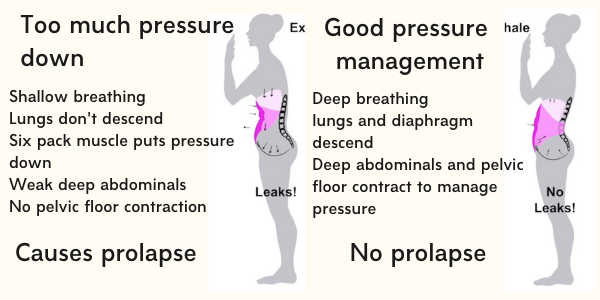Are suffering pelvic organ prolapse (POP)? This is a relatively common experience for postpartum women and women as they get older. According to the Continence Foundation of Australia over half of all women who have had a child have some level of POP. In the USA 58% of women who opt to have surgery for POP will experience a recurrence after surgery! (Whiteside and Weber, 2004).
There are many different types and causes of prolapse and this question will always need to be answered on a case by case basis but I am here to say that it is possible to improve a prolapse with breathing techniques and gentle exercise.
What is pelvic organ prolapse?
The pelvic organs, the bladder, uterus, large intestine and rectum are held in place by fascia muscles and ligaments. Without proper support due to weak, tight, torn or damaged fascia, ligaments or muscles, pelvic organs can bulge down into the vagina or rectum. That is a prolapse. For more information on symptoms, risk factors and diagnosis check out this Queensland Health webpage.
Causes of pelvic organ prolapse
There are 2 main causes of pelvic organ prolapse.
- Too much pressure in the abdominal cavity (this is why surgery often fails)
- Tearing and stretching from delivery
In both instances women can achieve a high resolution of symptoms from specific movement and breathing.
Too much pressure – what does that mean?
I talk a lot in my classes about managing pressure in your torso. Why? Because our breath acts like a pump that creates pressure in our torso. This pressure helps to keep our bones safe from impact. If the muscles in our torso are not strong enough or moving in coordination then either there is not enough pressure in the torso or there is too much pressure being pushed down onto the pelvic floor.
There is a risk that any abdominal workout will increase the pressure down on the pelvic floor too much. This is why a focus on breathing correctly to recruit the abdominal muscles properly and in the right order is so important, to strengthen rather than weaken or damage the pelvic floor muscles.
This picture shows some of the issues of too much pressure down:

What to do
- See a pelvic floor Physical Therapist or OBGYN who can give you a clear diagnosis and assess the condition of your pelvic floor muscles.
- If you have done a lot of kegel exercises your pelvic floor maybe very tight. Check whether you can relax your pelvic floor (this helps the diaphragm and lungs descend)
- Pay attention to your posture and alignment
- Pay attention to your breath
- Work with a Pelvic floor corrective exercise specialist (like me!)
I am Brigid Pearse a certified Pilates instructor, an ex-dancer and a mum. I run a fully equipped Pilates studio from my home in Lennox Head and I run community Pilates mat classes in Byron Bay, Ballina and online. To receive regular body wisdom sign up below.






0 Comments